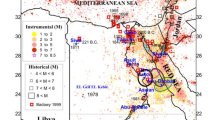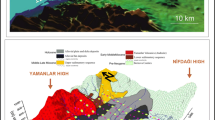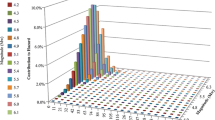Abstract
The site effect plays very important role for planning design of structures and estimating seismic damage of existing structures, especially in seismicity active regions. Aliağa, located in the northern region of the İzmir City, is high seismically active region in western Turkey. We identified the dynamic properties of shallow soil for Aliağa district (western Turkey) in terms of the average shear-wave velocity for the top 30 m of soil (Vs30), predominant period (T 0) and vulnerability index (Kg). We created the microzonation map that classes the shallow soil according to National Earthquake Hazards Reduction Program (NEHRP). Shear-wave velocity (Vs) was evaluated using the 1-D multichannel analysis of surface waves at 34 sites. The microtremor measurements were taken at 58 stations with a grid spacing of 1000 m in Aliağa district. The acquired HVSR results show that the T 0 values change from 0.1 to 1.9 s, while the amplification factor (A 0) values change between 1.5 and 12. Soil classification results illustrate that northern part of the study area, located in alluvial unit, has lower Vs30 values. These values are observed within the range of 100–300 m/s. This part was classified as the D and E types according to NEHRP. In addition, the weak zones of the study area due to the local site effects were indicated by the Kg values which vary from 5 to 55. The northern part of the study area is high vulnerability index zone (Kg > 20). Last of all, we can mention that the northern part of our study area is the weakest zone according to the results of geophysical and geological data.
Similar content being viewed by others
References
Adib A, Afzal P, Heydarzadeh K (2015) Site effect classification based on microtremor data analysis using a concentration–area fractal model. Nonlinear Process Geophy 22(1):53–63
Ahmad RA (2016) Seismic microzonation map of Syria using topographic slope and characteristics of surface soil. Nat Hazards 80(2):1323–1347
Akgün M, Gönenç T, Pamukçu O, Özyalın Ş, Özdağ ÖC (2013) Interpretation of integrated geophysical methods for the determination of engineering bedrock: İzmir new city center. UCTEA Chamb Geophys 26(2):67–80 (in Turkish)
Aktepe E, Aydın C (2013) Evaluation of seismotectonical studies around İzmir by using geographic ınformation systems and spatıal statistical methods. TMMOB GIS Congrees, Ankara
Albarello D, Francescone M, Lunedei E, Paolucci E, Papasidero MP, Peruzzi G, Pieruccini P (2017) Seismic characterization and reconstruction of reference ground motion at accelerometric sites of the Italian national accelerometric network (RAN). Nat Hazards 86(2):401–416
Anbazhagan P, Sitharam TG (2009) Spatial variability of the depth of weathered and engineering bedrock using multichannel analysis of surface wave method. Pure appl Geophys 166(3):409–428
Anbazhagan P, Sitharam TG, Vipin KS (2009) Site classification and estimation of surface level seismic hazard using geophysical data and probabilistic approach. J Appl Geophys 68(2):219–230
Asten WM (2006) On bias and noise in passive seismic data from finite circular array data processed using SPAC methods. Geophysics 71(6):153–162
Bard PY (1998) Microtremor measurements: a tool for site effect estimation. In: Proceedings of 2nd ınternational symposium on the effect of surface geology on seismic motion, vol III, Yokohama, Japan, pp 1251–1279
Beroya MAA, Aydin A, Tiglao R, Lasal M (2009) Use of microtremor in liquefaction hazard mapping. Eng Geol 107(3):140–153
Cantore L, Convertito V, Zollo A (2010) Development of a site-conditions map for the Campania-Lucania region (southern Apennines, Italy). Ann Geophys 53(4):27–37
Dewi SNADC, Lestari RT, Soemitro RAA, Warnana DD (2016) Earthquake microzonation and V S, 30 mapping based on microtremor measurement (Case Study in Kaliwates and Sumbersari Sub-District, Jember Regency). Proc Soc Behav Sci 227:354–360
El-Hady S, Fergany EAA, Othman A, Mohamed GEA (2012) Seismic microzonation of Marsa Alam, Egypt using inversion HVSR of microtremor observations. J Seismolog 16(1):55–66
El-Hussain I, Deif A, Al-Jabri K, Mohamed AME, Al-Rawas G, Toksöz MN, Al-Saif M (2013) Seismic microzonation for Muscat region, Sultanate of Oman. Nat Hazards 69(3):1919–1950
Eşder T, Yakabağ A, Sarıkaya H, Çiçekli K (1991) Aliağa (İzmir) yöresinin jeolojisi ve jeotermal enerji olanakları. MTA Gen Mud Ege Bol Mud Rep
Genç ŞC, Yılmaz Y (2000) Geology and young tectonics of aliağa environment. seismicity of Western Anatolia Symposium, pp 152–159, İzmir (in Turkish)
Gitterman Y, Zaslavsky Y, Shapira A, Shtivelman V (1996) Empirical site response evaluations: case studies in Israel. Soil Dyn Earthq Eng 15:447–463
Kanlı AI, Tildy P, Prónay Z, Pınar A, Hermann L (2006) VS30 mapping and soil classification for seismic site effect evaluation in Dinar region, SW Turkey. Geophys J Int 165(1):223–235
Konno K, Ohmachi T (1998) Ground-motion characteristics estimated from spectral ratio between horizontal and vertical components of microtremor. Bull Seismol Soc Am 88:228–241
Kyaw ZL, Pramumijoyo S, Husein S, Fathani TF, Kiyono J (2014) Investigation to the local site effects during earthquake induced ground deformation using microtremor observation in Yogyakarta, Central Java-Indonesia. In: Sassa K, Canuti P, Yin Y (eds) Landslide science for a safer geoenvironment. Springer, Cham, pp 241–249
Lachet C, Bard PY (1994) Numerical and theoretical ınvestigations on the possibilities and limitations of Nakamura’s technique. J Phys Earth 42(5):377–397
Lermo J, Chavez-Garcia FJ (1993) Site effect evaluation using spectral ratios with only one station. Bull Seismol Soc Am 83:1574–1594
Lermo J, Chavez-Garcia FJ (1994) Are microtremors useful in site response evaluation? Bull Seismol Soc Am 84:1350–1364
Montalva GA, Chávez-Garcia FJ, Tassara A, Jara Weisser DM (2016) Site effects and building damage characterization in Concepción after the Mw 8.8 Maule earthquake. Earthq Spectra 32(3):1469–1488
Motazedian D, Hunter JA, Pugin A, Crow H (2011) Development of a VS30 (NEHRP) map for the city of Ottawa, Ontario,Canada. Can Geotech J 48(3):458–472
Nakamura Y (1989) A method for dynamic characteristics estimation of subsurface using microtremor on the ground surface. QR Railw Tech Res Inst 30:25–33
Nakamura Y (1997) Seismic vulnerability indices for ground and structures using microtremor. World Congress on Railway Research, Florence
Nakamura Y (2000) Clear identification of fundamental idea of Nakamura’s technique and its applications. In: Proceeding 12th world conference on earthquake engineering, vol 2656
NEHRP (1997) recommended provisions for seismic regulations for new buildings and other structures, FEMA-303. Prepared by the building seismic safety council for the Federal Emergency Management Agency, Washington, DC
Pamuk E, Özdağ ÖC, Özyalın Ş, Akgün M (2017) Soil characterization of Tınaztepe region (İzmir/Turkey) using surface wave methods and nakamura (HVSR) technique. Earthq Eng Eng vib 16(2):447–458
Panzera F, Lombardo G, Monaco C, Di Stefano A (2015) Seismic site effects observed on sediments and basaltic lavas outcropping in a test site of Catania, Italy. Nat Hazards 79(1):1–27
Park CB, Miller RD, Xia J (1999) Multichannel analysis of surface waves. Geophysics 64(3):800–808
Roser J, Gosar A (2010) Determination of Vs30 for seismic ground classification in the Ljubljana area, Slovenia. Acta Geotech Slov 7:61–76
Rueda J, Mezcua J, Blanco RMG, Núñez A, de Villalta MF (2015) Seismic scenario including site-effect determination in Torreperogil and Sabiote, Jaén (Spain), after the 2013 earthquake sequence. Nat Hazards 79(2):675–697
Singh AP, Annam N, Kumar S (2014) Assessment of predominant frequencies using ambient vibration in the Kachchh region of western India: implications for earthquake hazards. Nat Hazards 73(3):1291–1309
Sugianto N, Farid M, Suryanto W (2016) Local geology condition of bengkulu city based on seismic vulnerability index (Kg). ARPN J Eng Appl Sci 11(7):4797–4803
Teves-Costa P, Matias L, Bard PY (1996) Seismic behaviour estimation of thin alluvium layers using microtremor recordings. Am Geophys Union 15:201–209
Warnana DD, Ria RAA, Widya Utama W (2011) Application of microtremor HVSR method for assessing site effect in residual soil slope. Int J Basic Appl Sci IJBAS IJENS 11(04):73–78
Yalçınkaya E (2010) Why is the soil so important ? UCTEA Chamb Geophys Bull 63:77–80 (in Turkish)
Acknowledgements
The MASW and microtremor data which obtained in this research were financially supported by TUBITAK-KAMAG (Project No. 106G159).
Author information
Authors and Affiliations
Corresponding author
Rights and permissions
About this article
Cite this article
Pamuk, E., Özdağ, Ö.C., Tunçel, A. et al. Local site effects evaluation for Aliağa/İzmir using HVSR (Nakamura technique) and MASW methods. Nat Hazards 90, 887–899 (2018). https://doi.org/10.1007/s11069-017-3077-y
Received:
Accepted:
Published:
Issue Date:
DOI: https://doi.org/10.1007/s11069-017-3077-y












